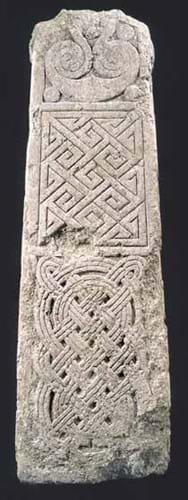Even now, as Sotheby's put an estimate of $30,000-50,000 on what the British authorities have deemed to be a modern reproduction, many leading experts are still thought to believe that a cross shaft bought by antiquities dealer Rupert Wace at a provincial UK auction is a genuine Anglo-Saxon 8th/9th century original worth hundreds of thousands of pounds.
The remarkable story of the cross, pictured right, which is being offered in New York as the last lot in Sotheby's June 9 antiquities sale, began in November 2001, when Mr Wace found what he thought was a sleeper at Norfolk auction house T.W. Gaze and Son, where the hammer fell to him at £7500.
The cross had been consigned, with an estimate of £100-150, by the owner of a local garden centre, who is thought to have acquired it from the Staffordshire village of Gailey, where similar crosses, many of them known 19th century copies, are to be found.
Mr Wace made the cross the centrepiece of his Grosvenor House stand in June 2002, where, having been subjected to the scrutiny of the vetting committee, it proved to be one of the most admired objects at the fair and sold for what is thought to have been about £300,000.
When the cross was put up for export to its American buyer, an institution, its potential importance meant it had to be assessed by experts on behalf of the Government-appointed Export Review Committee, who advise Ministers on whether works of art should be allowed out of the country.
This left Mr Wace at the centre of a paradox. If the cross was deemed to be the genuine Anglo-Saxon original he believed, he would not be allowed to export it to the buyer. If, however, it was judged a modern creation, he would be free to do so, but as he had guaranteed the object to the buyer it was unlikely that the transaction would be completed.
The committee were advised by Professor Rosemary Cramp (retired Durham University), editor of the Corpus of Anglo-Saxon Stone Sculpture, and an independent assessor whose identity has been kept secret by the committee but who is understood to be a British Museum curator.
Professor Cramp advised the committee that the cross was not Anglo-Saxon but a modern reproduction. She is cited as stating that the carving technique did not fit the earlier period.
Little or nothing more was heard about the fate of the cross until Sotheby's published the catalogue for the June 9 antiquities sale in New York.
Mr Wace would not comment on whether he is the vendor, but it is widely thought that he is and the catalogue gives a clue in listing the last change of ownership as taking place at the Gaze sale where he was the successful bidder.
The strange case of the carved cross…
ONE of the most unusual disputes concerning an item sold at auction comes full circle on Wednesday, with the object being put up for sale once more.





